There are 30 companion plants for radishes in this list along with 9 types of plants you should avoid.
If you’re planning on planting radishes in your garden, then this list will help you in knowing what to plant near them and what to avoid growing in the same area. Keep reading to know more about good and bad companion plants for radishes.
Radishes are edible root vegetables of the biological family Brassicaceae, also known as the cabbage family. They come in different types and colors, from white to purple and even red. They have a sharp odor due to their pungent odor.
These vegetables are grown and eaten in different places throughout the world today. They may be cooked or eaten raw with and as vegetables. When raw, their flavor is pungent but cooking makes their taste milder and brings out their sweetness.
Table of Contents
They have a spicy, crisp and zesty taste when eaten raw. Different types of radishes range in spiciness, from very spicy to very mild. Although they are safe to consume, eating radishes in large quantities may cause flatulence, cramps and irritation to the digestive tract.
Radishes are about 95.3% water, 3.4% carbohydrates, and their fat and protein contents are very little. They also contain several vitamins and minerals which make them very useful and healthy for human consumption.
Radishes supply the vitamins B1 (thiamine), B2 (riboflavin), B3 (niacin), B5 (pantothenic acid), B6, B9 (folate), C, and the minerals calcium, iron, magnesium, manganese, potassium, phosphorus and zinc to the body.
Adding radishes, which are rich in antioxidants and minerals, to your diet can cause a decrease in blood pressure while also reducing the risk of heart disease. The radish is also a good source of natural nitrates that improve blood flow.
For the best results when planting this root vegetable, grow it in a spot where it will receive full sun in cooler weather. It also thrives underneath partial shade but in the warmer months of the year, grow it in full shade.
Maintain a steady and even level of moisture within the soil also. Keep this soil cool, loose and moist. It must be well drained and fertile (rich in organic matter), with a slightly acidic to neutral pH of 6.0 to 7.0.
While radishes are good at repelling some pests, they are still prone to pest infestation and bacterial diseases. They are attacked by aphids, cabbage loopers, flea beetles, harlequin bugs, cabbage maggots, cutworms, thrips, armyworms, whiteflies and others.
There are however several other crops which may be planted with them in your garden to encourage their growth, help keep pests away, attract useful insects, replenish soil nutrients and provide ground cover or shade from sunlight.
Such grouping for the purpose of sharing benefits is called companion planting. It is a tried and true method, ensuring for years that crops are grown with some other crops that help them grow healthy.
In this article, you will learn about thirty (30) good companion plants and nine (9) bad companion plants for radishes in your garden. Also explained below are reasons why they are or are not ideal beside your plant.
Good Companion Plants for Radishes
Alliums
1. Chives
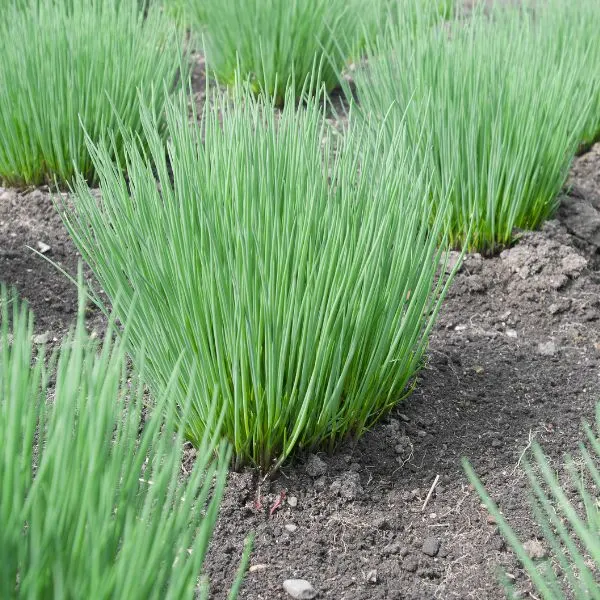
Chives are flowering plants in the genus Allium, to which some other aromatic plants like garlic, onions and shallots also belong. They are cultivated for the edible leaves and flowers they produce, which are then used to season food.
Like other alliums, they are good companions for radishes in the garden for their effectiveness at controlling pests. Chives and other alliums contain sulfur, the natural antifungal and antibacterial compound.
Chives help control both pests and diseases. They deter aphids, flea beetles, mites, deer, gophers, groundhogs and rabbits. They also have stunning purple-pink flowers that attract insects to aid pollination and control pests. Consider using a physical barrier in the soil to avoid competition.
2. Garlic

This is another plant in the genus Allium. The flowering plant has a pungent bulb divided into cloves which is used to season food or make an oil sprayed to deter pests. Garlic is a very good companion plant for radishes.
Because it contains sulfur, the allium has a strong smell and can prevent the infestation of pests, fungal diseases and bacterial infections. By emitting this fungicide, garlic improves the health of radishes and shields them from fungal diseases.
The joint pungent odors of radishes and garlic can keep many pests away from both crops and other ones in the area. Also, garlic is said to improve the flavor of radishes and other garden veggies if they are grown side by side.
3. Leeks
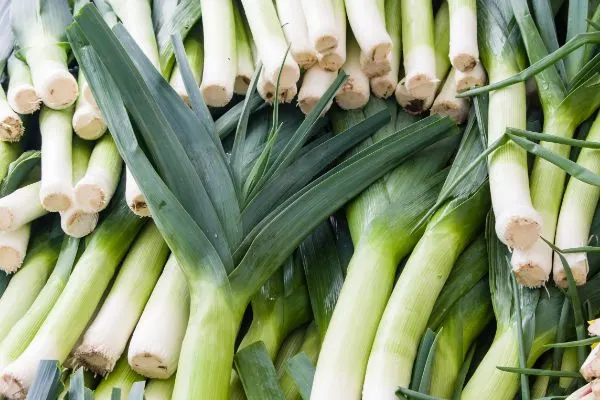
The leek is another flowering plant within the genus Allium. It possesses a large and slender white bulb and flat dark green leaves that overlap. Like other pungent members of its family, it is used in cooking.
Leeks are some of the best companion plants for radishes. They can help to repel some natural predators of this plant, like aphids, flea beetles, deer, gophers, groundhogs, rabbits and other foraging rodents like rats and mice.
Their sulfur content lends them their pungent smell, which most insects hate, and their strong, sharp and stinging taste, which deer and rodents hate. The flowers of leek plants also attract pollinators to foster reproduction in both plants.
4. Onions
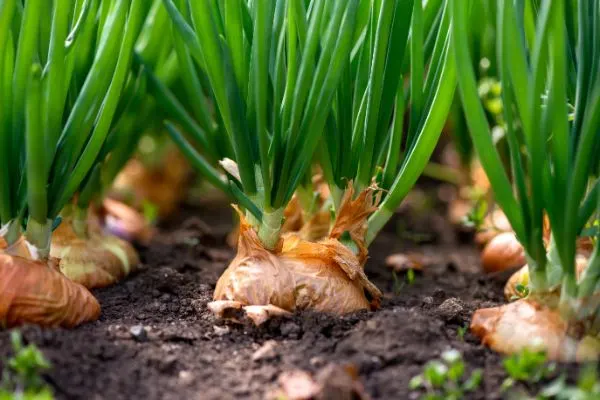
An onion a flowering plant in the genus Allium with bluish green leaves and a bulb at its base. This bulb is made up of shortened underground stems and fleshy modified leaves. Onion is the most widely cultivated vegetable in its genus.
Onions are able to deter several pests like aphids, beetles, deer, rabbits, weevils and whiteflies because they have natural fungicidal properties that can help protect radishes from several fungal diseases.
The roots of onion plants also break up tough clumps of soil and give your radishes much needed space to grow in the soil. It is also believed that the presence of onions improves the taste of plants nearby when they are grown side by side.
5. Scallions
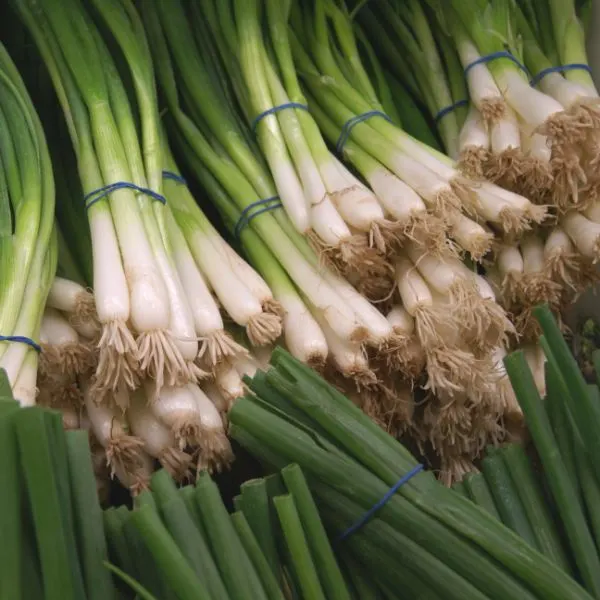
Scallions or green onions are a species in the genus Allium. They are typically milder in taste than other alliums and lack a fully developed bulb. Their hollow, tubular leaves are eaten cooked or raw as a vegetable.
Like other members of their genus, scallions aid pest control, they may improve the flavor of radishes and the other plants around them, and they attract various useful animals like pest predators and pollinators.
Brassicas
6. Broccoli
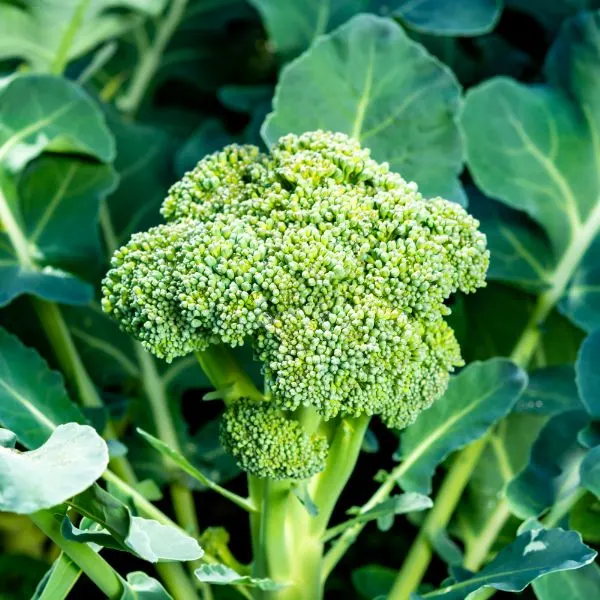
Broccoli is a flowering plant in the family Brassicaceae, the cabbage family. It has large, partly developed green flowers that make up its head, stalks and leaves which are the edible parts of the plant and the main reason it is cultivated.
Broccoli and some other brassicas are good companion plants for radishes and they naturally go well with each other without causing any harm. They both are heavy feeders and radishes prefer soil that is rich in organic matter.
This crucifer provides nitrogen-fixing properties that benefit beets. Because both of these plants bear flowers, growing them together attracts pollinators, be they birds or insects, to that area of your garden.
7. Brussels Sprouts
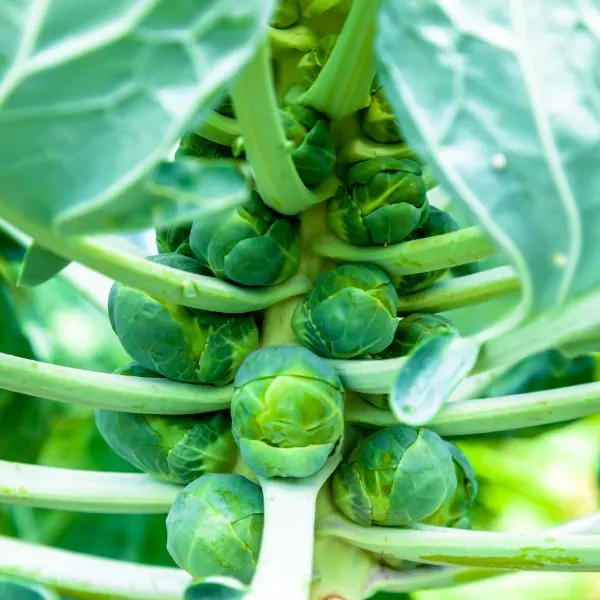
Another brassica that serves as a good companion for your radishes is Brussels sprout. Brussels sprouts are flowering plants in the cabbage family grown for their edible buds. They are green leafy vegetables resembling very small cabbages.
As flowering plants, both Brussels sprouts and radishes attract insects and animals to the garden to help with the reproductive process of pollination. Both plants are heavy feeders, requiring quite more nutrients than most plants.
However, Brussels sprouts also fix nitrogen in the soil, reducing the stress of this companionship on the soil. It will be beneficial to add plants that attract pest predators or repel common plant pests to the companionship.
8. Cabbage
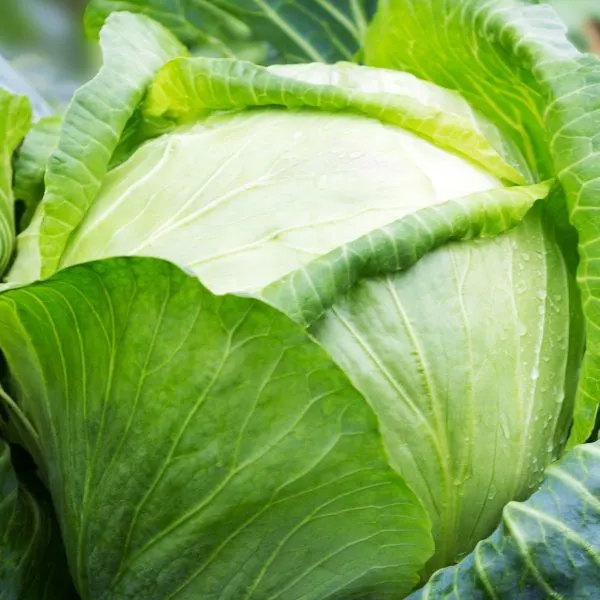
Another brassica that is a good companion plant for radishes is cabbage. Cabbage is a flowering biennial plant mostly grown as a vegetable crop for its edible and tightly packed leaves. Leaves are layered and may be white, red or green.
Cabbage is also a heavy feeder but it provides radish with the nitrogen it needs for optimal growth. It also releases biotoxins that work against several soil borne pathogens. The toxins show activity against bacteria, nematodes and fungi.
They are also active against several weeds. Cabbages also provide good ground cover so they help control erosion and the growth or spread of weeds. They also capture nitrogen from within the soil after harvest for the benefit of radishes.
9. Cauliflower
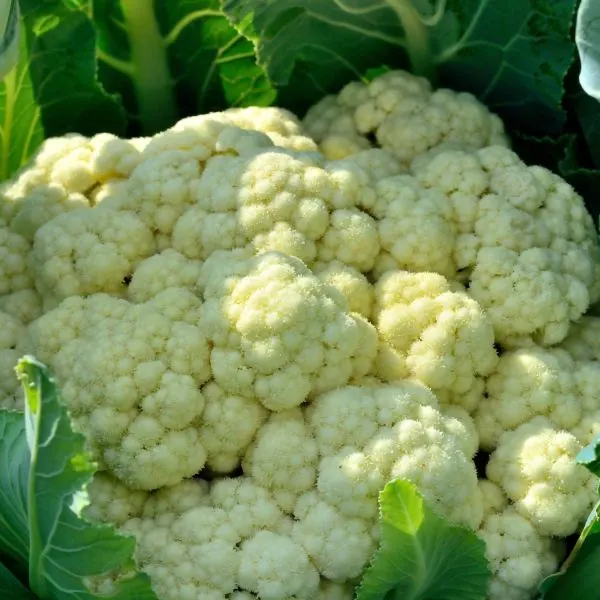
Cauliflower is another flowering plant in the Brassicaceae family, cultivated for its partially developed flowers, referred to as the head or “curd”. The head is edible and mostly in the colors white, yellow, green, orange, brown or purple.
Just as some other brassicas naturally go well with radishes in the garden bed, cauliflower also makes a great companion for its fellow brassicas. It can help with some amount of pest control while serving as ground cover.
Some plants in the cabbage family, although inconsistently, release chemical compounds called biotoxins that may be toxic to soil borne pathogens, pests, nematodes, fungi and weeds. Cauliflower captures nitrogen in the soil and helps to control erosion by providing good ground cover.
10. Kale
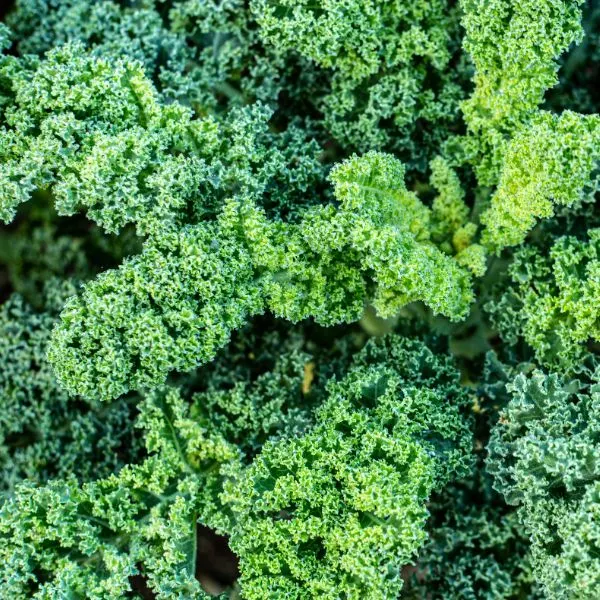
Another brassica that serves as a good companion plant for radishes is kale. Kale, also called leaf cabbage, is a flowering plant with edible green or purple leaves that do not form a central head. Its leaves may be eaten or ornamental.
Kale and radishes naturally go well beside each other in the garden. Kale provides ground cover and aids pest control. It also releases some amounts of biotoxins which may be toxic to several pathogens and pests that live in the soil.
This means that kale can help protect your radishes from fungi, nematodes and some weeds. It also solves or helps curbs the problems of erosion and weeds which are some consequences of having open, bare soil in your garden.
Kale can capture nitrogen remaining in the soil after harvest, and this nutrient is very important for plant development. Be careful when planting radishes with other brassicas generally to avoid competition or reduce it as much as possible.
Flowers
11. Borage
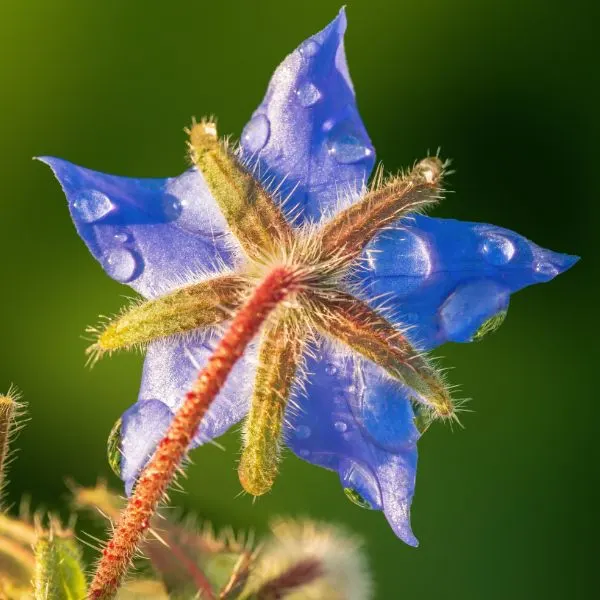
Also known as starflower, borage is an annual herbaceous flowering plant in the family Boraginaceae. It has complete flowers with five narrow, triangular-pointed petals. These are predominantly blue but also occur in white and pink.
Borage is another plant that can aid pollination because it attracts lots of bees and other pollinating insects to your garden. This plant is also known to use its deep taproots for the benefit of plants near it.
Borage can bring up minerals and water from deep within the soil to make them accessible to nearby plants, like radish, while also building calcium within the soil. It is a good companion plant for radishes.
12. Marigolds
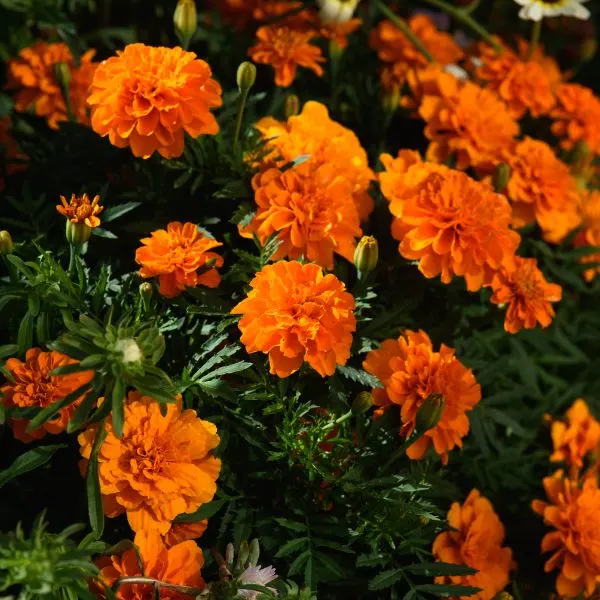
Marigolds are mostly herbaceous flowering annual or perennial plants which belong to the daisy family Asteraceae. Because of their flowers and odor, they are good companion plants for radishes.
They have bold and beautiful gold, orange, white or yellow flowers which are known to attract butterflies, bees and other helpful insects. These insects aid pollination and eat pests in your garden.
Marigolds have a pungent odor and have green feather-like leaves. Their scent helps to repel several insect and animal pests but they may also be utilized as trap crops. They can also be used to fill empty spots in the garden.
13. Nasturtiums
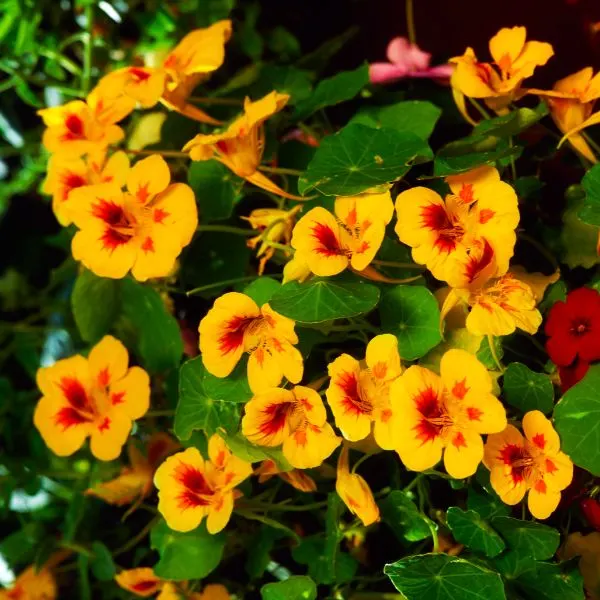
Also known as tropaeolum, nasturtium is a genus of plants that contains several creeping herbaceous plants which may be annual or perennial. These plants have showy round flowers and may be used in herbal medicine or cooking.
Nasturtium is another very good companion plant for radish. It is a natural and powerful pest deterrent. It also serves as a trap crop by attracting pests that could be attracted by other plants to itself.
Benefiting radishes further, nasturtiums attract predatory insects and pollinators with their beautiful, vibrant red and orange flowers. It is also believed that nasturtiums can improve the flavor profile of other plants near them.
Herbs
14. Chervil
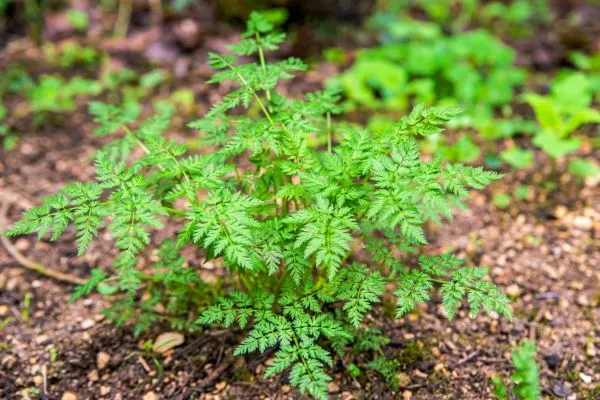
Chervil, French parsley or garden chervil is a delicate annual herb in the carrot family Apiaceae. It is used in the making of an oil with a resinous aroma. It is commonly used to season mild-flavored French dishes and has small white flowers.
Like many other herbs, chervil is a very good companion plant die radishes. It is somatic, meaning that it has a strong scent. It is believed that t her herb improves the taste and texture of radishes and is a repellent of pests like aphids.
15. Dill
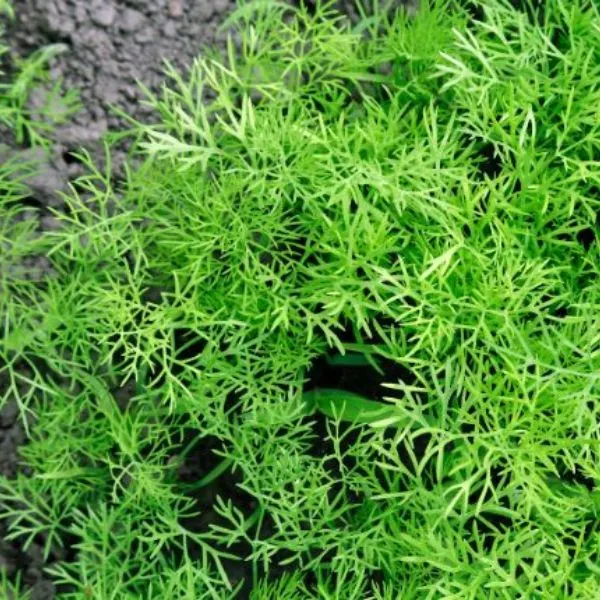
Dill is an annual herbaceous flowering plant in the celery family cultivated for its leaves and seeds. These may be used as herbs or as a seasoning for food. This plant, widely grown in Europe and Asia, is a very good companion for radishes.
Both are comfortable together as they thrive in similar conditions. With its flowers, dill helps attract useful insects like bees and butterflies to the area. These insects aid pollination.
Dill’s flowers also draw insects that feed on common pests of garden crops. Hoverflies, lacewings, ladybugs and beneficial wasps are some such insects that dill attracts. They feed on aphids, caterpillars, leafhoppers, thrips, whiteflies and others.
16. Mint
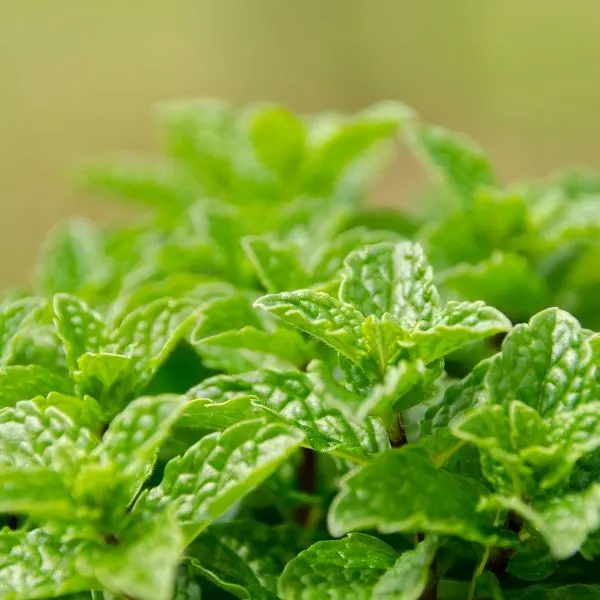
Mint is a genus of about sixty aromatic herbaceous flowering plants in the biological family Lamiaceae. Most plants in this genus are perennial, with several species, cultivars and hybrids, like peppermint, which is really good for rhubarb.
Radishes really benefit from having mint plants beside them. Mint repels several animal and insect pests including aphids, cabbage loopers, cutworms, deer and flea beetles. It can also aid reproduction by attracting pollinators to your garden.
Although it also improve the taste of your radishes, mint has quickly spreading horizontal roots that are likely to compete with the roots of radish. It will help to plant your mint in a separate container and then place it beside your radishes.
17. Oregano
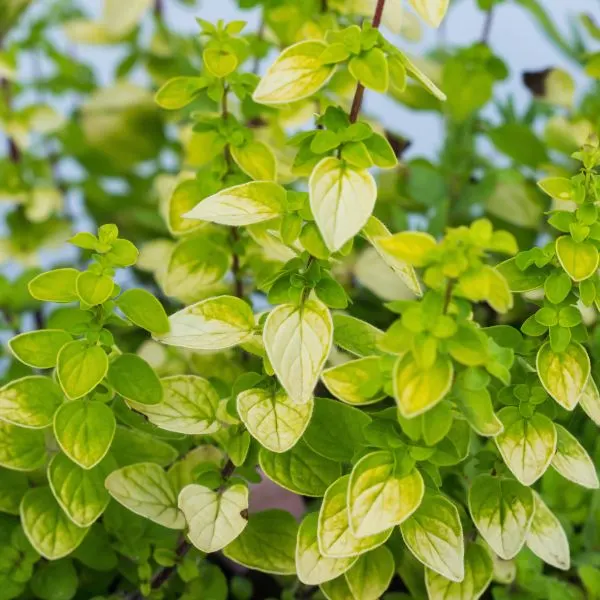
Oregano is a very good companion plant for radishes. It is a woody flowering perennial plant in the mint family Lamiaceae. It may be harvested after a growing season but its flowers may not have bloomed yet.
When allowed to blossom, the beautiful flowers of the oregano plant draw several beneficial insects to your garden. They may be agents of pollination, like bees and butterflies, or predatory ones like ladybugs that feed on crop pests.
Even without its flowers, oregano is beneficial to radishes. Its strong, pungent smell is able to keep some pests away. It is tolerant of low moisture conditions, as it needs moderate amounts of water, so it would not compete with your plant.
18. Rosemary
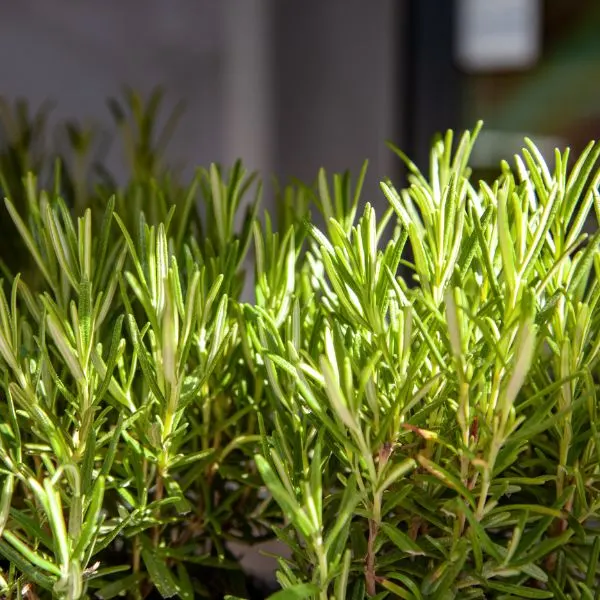
Rosemary is a low, woody perennial plant with thin and needle-like leaves which are fragrant and evergreen. Its flowers may come in blue, white, pink or purple. It is a herbaceous flowering plant in the mint family Lamiaceae.
Radishes and rosemary benefit each other. Radishes have beautiful flowers and leaves that attract beneficial insects to the rosemary plant. These insects may help in pollination or biological control of crop pests.
The scent of rosemary (and any other strong smelling herb) is a deterrent to several pests that might want to attack your radish plants.
19. Sage
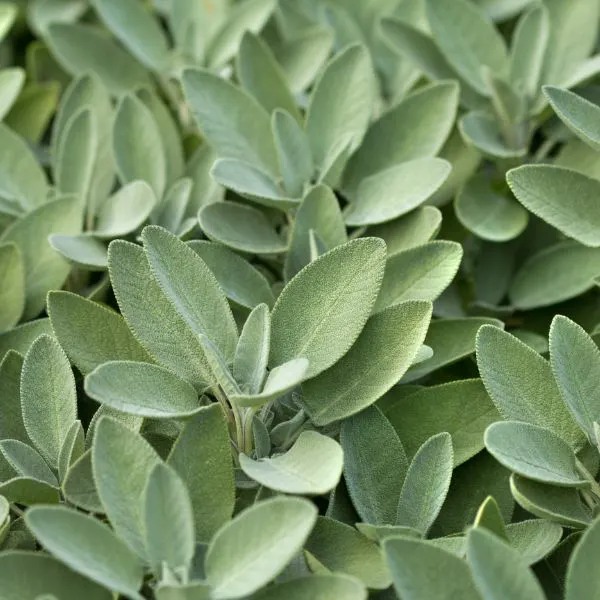
Sage is a herbaceous flowering plant that belongs to the mint family Lamiaceae. It has distinct grayish green leaves, bright purple flowers and a strong odor. It is another herb that serves as a good companion plant for radishes.
Both plants have similar growth needs and sage has the ability to attract predatory insects to feed on nearby pests while harming neither the sage nor your radishes. Its flowers attract bees, butterflies and other pollinators to your garden.
The taproots of radishes need space to grow in the deeper layers of the soil. Sage can help them access this much needed space by breaking up tough soil clumps, aerating these deeper layers.
Legumes
20. Peas
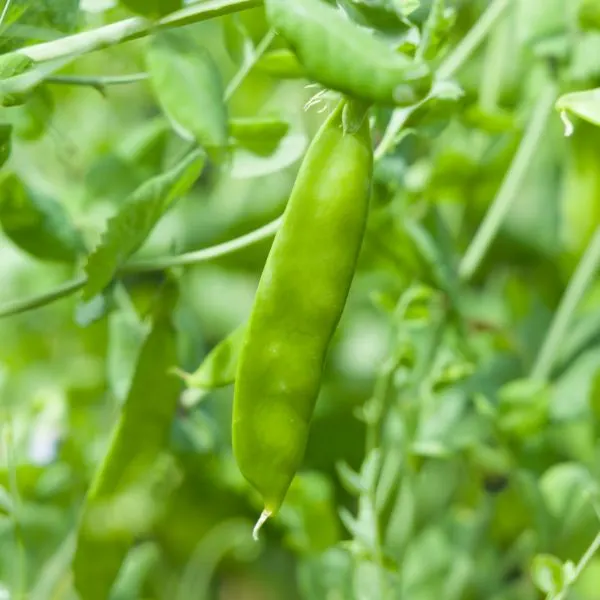
A pea plant is an annual herbaceous flowering plant in the biological family Fabaceae. Also known as garden pea, the plant is cultivated in various parts of the world for its edible seeds, peas, cooked as vegetables.
The plant is leguminous, meaning that it helps fix nitrogen in the soil, serves as a cover crop and may be used as mulch after it is grown. Peas aid the conversion of atmospheric nitrogen into nitrates that other plants can absorb and use.
Nitrogen aids growth in plants’ leaves which are important in photosynthesis. Peas also prevent erosion, conserve water in the soil, discourage the growth of weeds and stop the spread of pests and diseases. Mulching them after harvest releases more nitrogen into and protects the soil.
21. Pole Beans
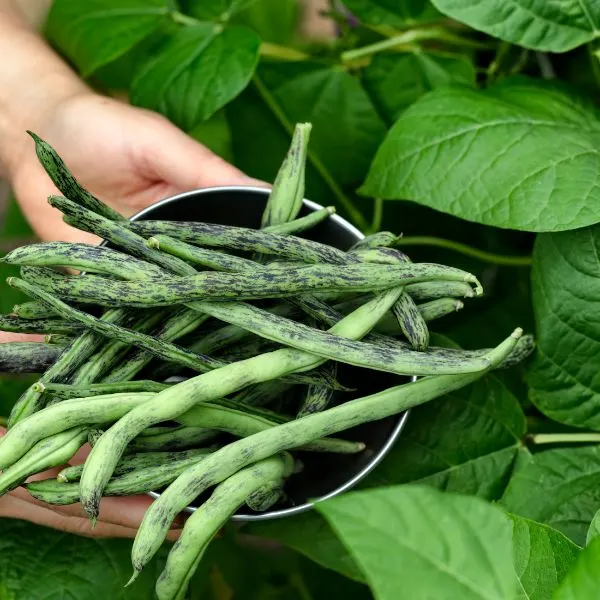
Beans are seeds of several genera of flowering plants that belong to the botanical family Fabaceae. The seeds are then boiled, fried, baked or cooked by some other method and used as vegetables for humans or animals to eat.
There are two kinds of beans: the more compact and low growing kind known as bush beans and the taller one called pole beans. Plant pole beans with radishes to protect them from excessive exposure to sunlight.
Beans, like peas, are legumes that help fix nitrogen in the soil. Radishes require a good amount of nitrogen to grow well and beans supply this nutrient, improving the quality of the yield of the plants.
Pole beans also provide good ground cover in your garden. This prevents the water loss that results from evaporation and reduces the growth of weeds. Also, their flowers attract even more pollinators to the radishes around.
Nightshades
22. Peppers
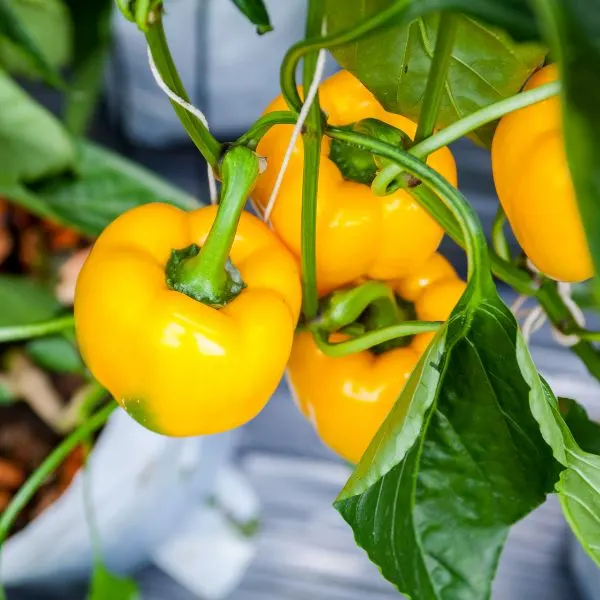
Pepper plants are flowering plants of the nightshade family Solanaceae. There are several species and cultivars of pepper plants existing. They produce peppers of various colors like red, yellow, orange and green.
Although peppers have deep taproots and are heavy feeders, they are good companion plants for radishes. Competition can be reduced by proper spacing and growing legumes. Pepper plants are compact and can maximize garden space.
Peppers are also low maintenance crops. Their flowers bring pollinators like bees and butterflies to your garden. They also deter aphids, cabbage worms, deer, mites and rabbits.
23. Tomatoes
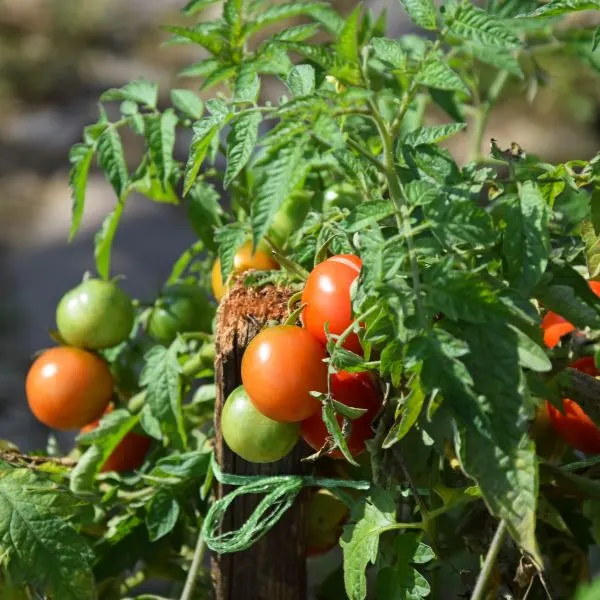
The tomato plant is a South American plant of the nightshade family Solanaceae. It produces a widely grown mildly acidic edible fruit also known as tomato, with many varieties in red or yellow color. It is pulpy and may be eaten raw or cooked.
Tomatoes are great companion plants for your radishes, despite also being heavy feeding crops, when spaced properly. They maximize garden space and attract pollinators by their flowers.
(Root) Vegetables
24. Beets
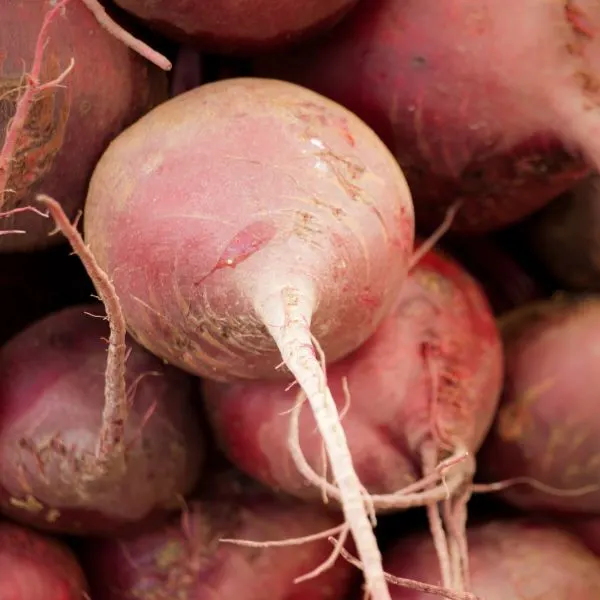
Beets are flowering brassicas that produce an edible and usually deep red taproot known as beetroot. The leaves of the plants, known as beet greens, may be eaten as vegetables. They are good companion plants for radishes.
Planting radishes and beets together helps to loosen the soil surrounding beets, allowing them more room to absorb water and nutrients. Both are also flowering plants so they improve each other’s growth and vigor by attracting pollinators.
They attract pollinators with their flowers. Radishes mature quickly but while they are growing, they serve as ground cover, help suppress weeds, and are harvested before your beet needs the space to spread more.
25. Carrots

Carrots are good companion plants for radishes. They are edible root vegetables with typically orange taproots and green leaves at the top. Cultivars in white, yellow, red, purple and black also exist, with this root typically tapering.
These edible root veggies can enhance the flavor of other crops around it. They can also maximize the space in your garden. Carrots needs to be grown around pungent crops to protect them from carrot root flies.
Radishes can aid pest control but both plants can still be attacked by insects like aphids. Growing herbs like mint and rosemary alongside this pair can help control pests. They use their strong aromas to mask the scent of growing carrots.
26. Lettuce
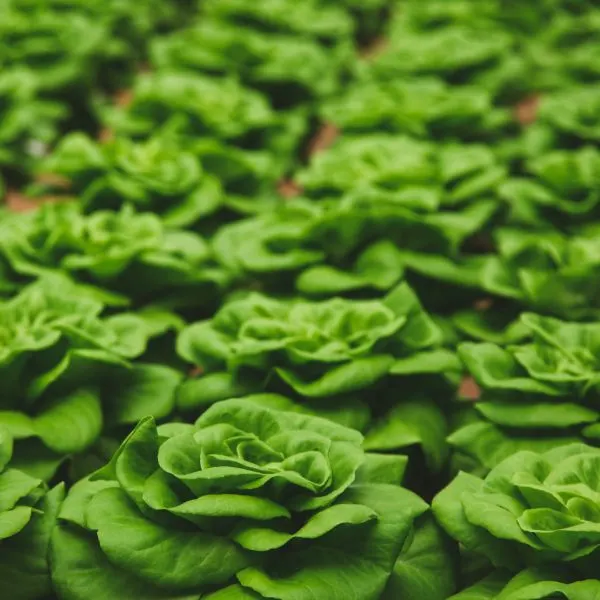
Lettuce is a flowering annual plant mostly cultivated for its leaves, used as a leaf vegetable. It is most often eaten in salads but may be added into other foods. Plant leaf lettuce near radish as it is a good companion plant for radishes.
Unlike radishes, lettuce plants have shallow roots. They do not compete with each other for space, water or nutrients. Lettuce and radish plants may attract some of the same pests but the latter can aid pest control.
Lettuce is plagued by slugs, aphids, cabbage loopers, caterpillars, cutworms, flea beetles, leaf miners, thrips, weevils and whiteflies. You may add another pungent plant like mint to help further control pests.
27. Parsnips
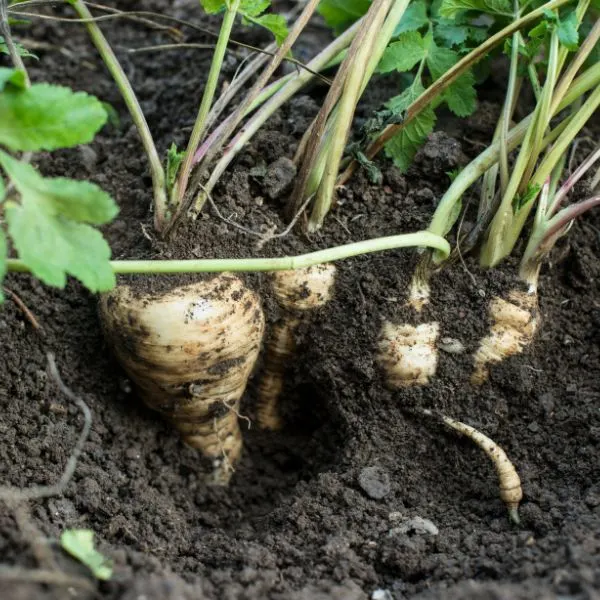
A parsnip is a flowering plant related to carrots and parsleys. It is an edible root vegetable that belongs to the botanical family Apiaceae. The harvested root is usually cream colored with leafy greens above it.
Parsnips attract predatory insects that feed on several crop pests, protecting the plants around them. Their roots produce a substance that is toxic to several insects that would be very harmful to your radishes and nearby plants.
28. Spinach
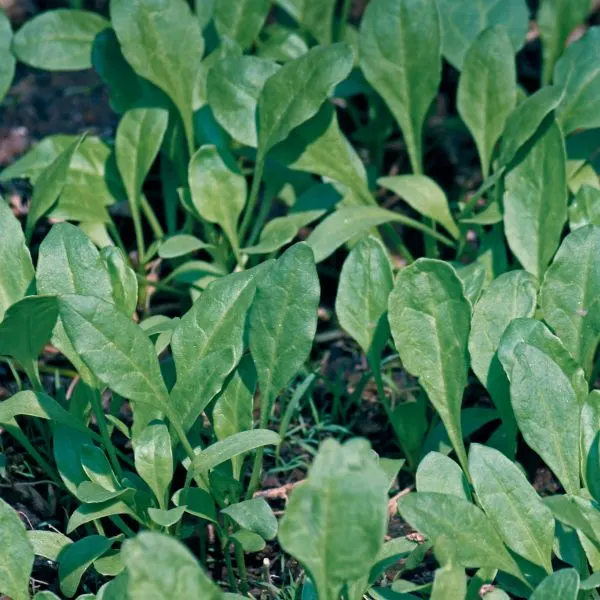
Spinach is a flowering plant in Amaranthaceae, the amaranth family. Its green leaves are edible and commonly eaten as a vegetable either raw or after preservation. Spinach is a good companion plant for radishes.
They do not compete because spinach has shallow roots. Also, spinach serves as a good ground cover, filling holes and spaces within your garden. This maximizes the potential and space of the garden.
Spinach helps with weed control within the area and provides some shade during the hotter parts of the day. This plant, like the radish, matures quickly.
29. Squashes

Squashes are herbaceous vegetables in the Cucurbitaceae family, the gourd family. This genus comprises many different species grown to be consumed as vegetables. They also serve as very good companion plants for radishes.
These plants need constant water supply in order to grow and maximize yield. They also enjoy full sunlight for about 6 hours daily. These requirements are similar to those of radishes, they will not significantly discomfort each other.
Several insects like aphids, cucumber beetles, pickle worms, spider mites, squash bugs and whiteflies can cause damage to squashes. Radishes can keep some of these pests away with their strong and sharp smell.
30. Zucchini
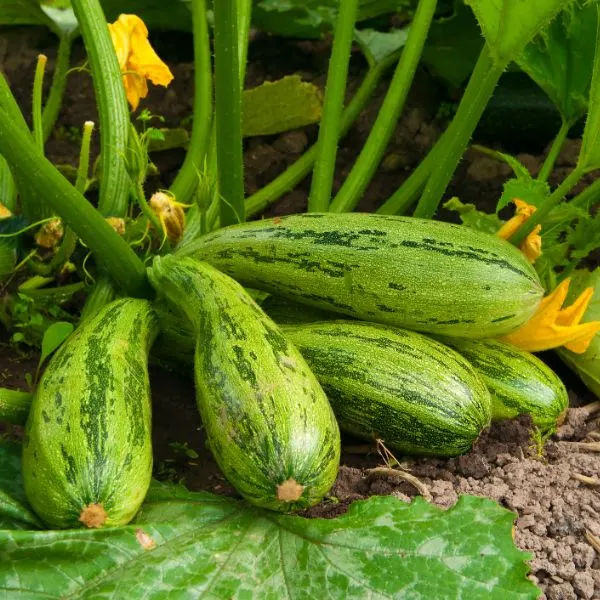
The vining plant called zucchini is also referred to as baby marrow, courgette or eggplant. It is a summer squash, a herb grown for its fruits which are harvested when they still have immature seeds and soft rinds that are edible.
Zucchini and radishes thrive in similar conditions so zucchini is a good companion plant for radish. Zucchini plants are large so they can shade radishes from excessive sunlight in hotter climates or weather.
Radishes can benefit this squash by aiding in the control of squash vine borers. Radishes are also heavy feeders and can attract similar pests so you can add a plant like tansy to control other pests.
Bad Companion Plants for Radishes
Cucurbits
1. Melons
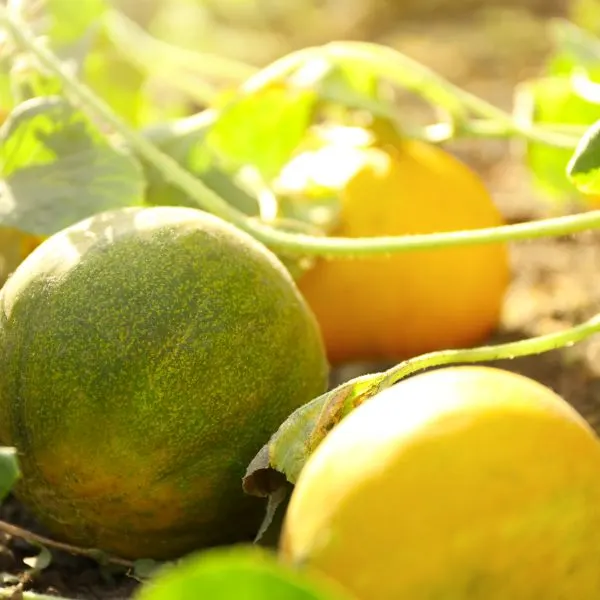
Melons are the various plants of the family Cucurbitaceae, the gourd family to which squashes or gourds belong. These flowering plants produce sweet, edible, and fleshy fruit. Both the plants and their fruits are referred to as melons.
Radishes do not grow well near melons; melons are bad companion plants for radishes. They can seriously fight for nutrients, sunlight and space. They may also attract similar pests, resulting in poor produce.
Melons especially struggle for sunlight with your radishes. They have large leaves that can shade out your root veggie. When radishes get little or no sunlight, they have impaired growth.
2. Pumpkins
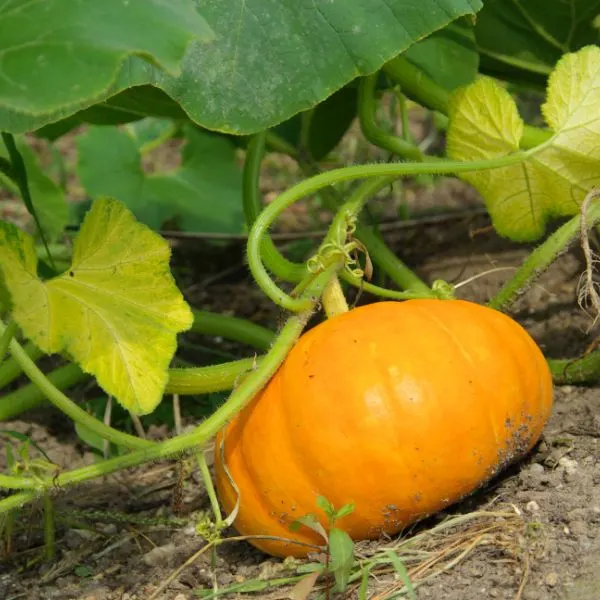
The pumpkin is a coarse vining plant widely cultivated for the fruit it produces. This pumpkin fruit is a large pulpy round fruit with firm orange skin and numerous seeds. This plant is also in the gourd family Cucurbitaceae.
Pumpkin is a bad companion plant for radishes. It competes aggressively with your plant for sunlight, water, nutrients and space. It can choke out radishes with its wide, sun-loving leaves.
Flowers
3. Hyssop
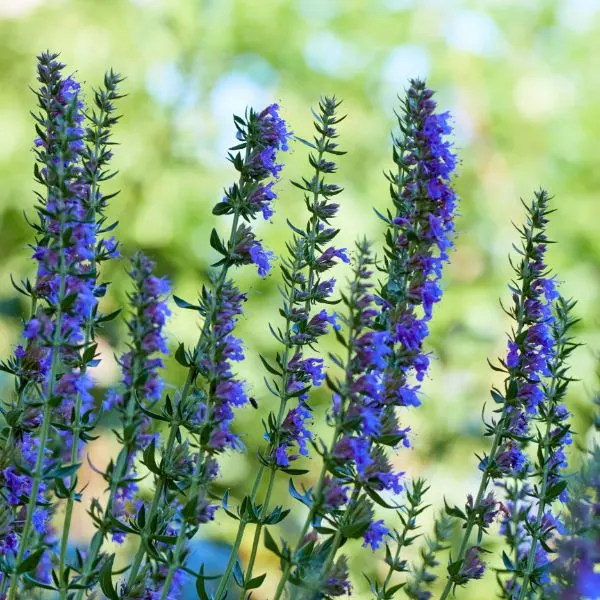
Hyssop is a herbaceous flowering plant in the mint family Lamiaceae. It has aromatic, pungent leaves. The parts that grow above the soil may be used in the making of perfumes and herbal medicine or as a seasoning for culinary purposes.
For other plants, hyssop would be a useful companion plant that attracts useful insects that aid pollination and feed on pests, while also serving as ground cover, shielding the soil from excess evaporation and preventing weed growth.
For radish, hyssop is an allelopath. Its allelochemicals (biochemicals that influence the developmental processes of other organisms, including germination, growth, survival and reproduction) can hinder or stunt the growth of radishes so keep these plants away from each other.
4. Sunflowers
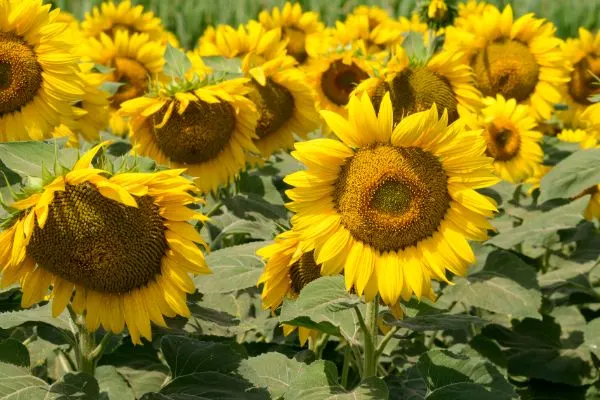
A sunflower is any species of annual and perennial plants that belong to the genus Helianthus in the family Asteraceae, the daisy family. They bear flowers which have large heads, dark disk florets and flamboyant yellow rays.
Sunflowers are susceptible to attacks from aphids, beetles, caterpillars, curculios, cutworms, moths, thrips and several kinds of weevils. Radishes can help control pest infestation in sunflowers.
However, sunflowers love the sun. They also grow tall so these plants can shade your radish plants too much from the sunlight. This will adversely affect your radishes.
(Root) Vegetables
5. Corn

Corn or maize is a species of monocotyledonous flowering plants in the grass family Poaceae or Gramineae. Its leafy stalk produces separate inflorescences known as ears. When fertilized, these ears yield fruits, which are the seeds.
This is a bad companion plant for radishes. Corn, like melon, pumpkin and sunflower, is a tall plant that would shade your radishes from the sun if planted too close to them. Avoid planting corn and radishes together.
6. Fennel
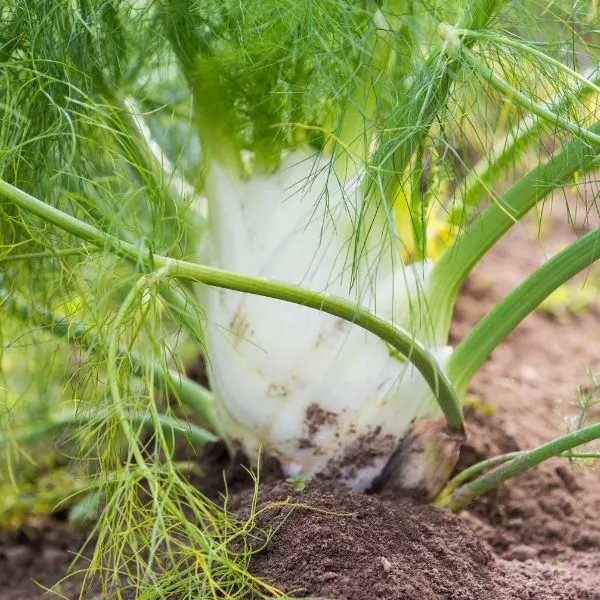
Fennel is a species of flowering plants in the carrot family. This hardy, perennial herb has yellow flowers and feathery leaves. It is yet another bad companion plant for radishes, as it contains allelochemicals.
The allelochemicals in fennel can cause it to inhibit and stunt the growth of radishes and many other garden plants. Keep these two far away from each other in the garden.
7. Kohlrabi

Another brassica you should not plant with kale is kohlrabi. It is a variety of wild cabbage with thin stems and yellow flowers also known as the German turnip. Its stems and leaves are edible and it tastes very much like cabbage.
Separate radishes from kohlrabi. This avoids unnecessary and unhealthy competition for root space and soil nutrients that would occur if they are planted side by side. Pests and diseases will be easily distributed and transmitted in such an area in addition to the competition.
Both plants would not fare well, or one would thrive while the other dies. Kohlrabi also grows taller on average than radish. It may block out the plant from receiving sunlight.
8. Potatoes
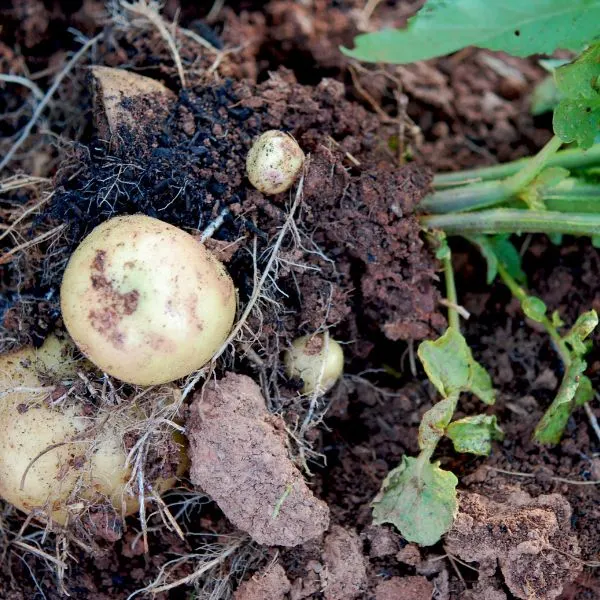
Potatoes are members of the nightshade family Solanaceae, like zucchini and peppers. They are perennial plants grown as root vegetables. These starchy tubers are also not suitable for growing near radishes.
As root vegetables, their roots grow downwards and reach low depths. They also need relatively high levels of water for maximum growth. To avoid unnecessary harmful competition, do not plant these crops next to each other.
9. Turnips

A turnip or white turnip is a flowering plant in the cabbage family Brassicaceae. This root vegetable is commonly grown in temperate climates worldwide for its edible, white and fleshy taproot which may be eaten raw or cooked.
Turnips are able to keep some pests away from your garden and control some diseases by releasing biotoxins into the soil. Biotoxins are chemical compounds that are toxic to some soil borne pathogens and pests.
This notwithstanding, turnips are bad companion plants for your radishes. The reason is that they are also fast growing root vegetables. They use up lots of nutrients and can compete with your radishes.
Infographic about radish companion plants
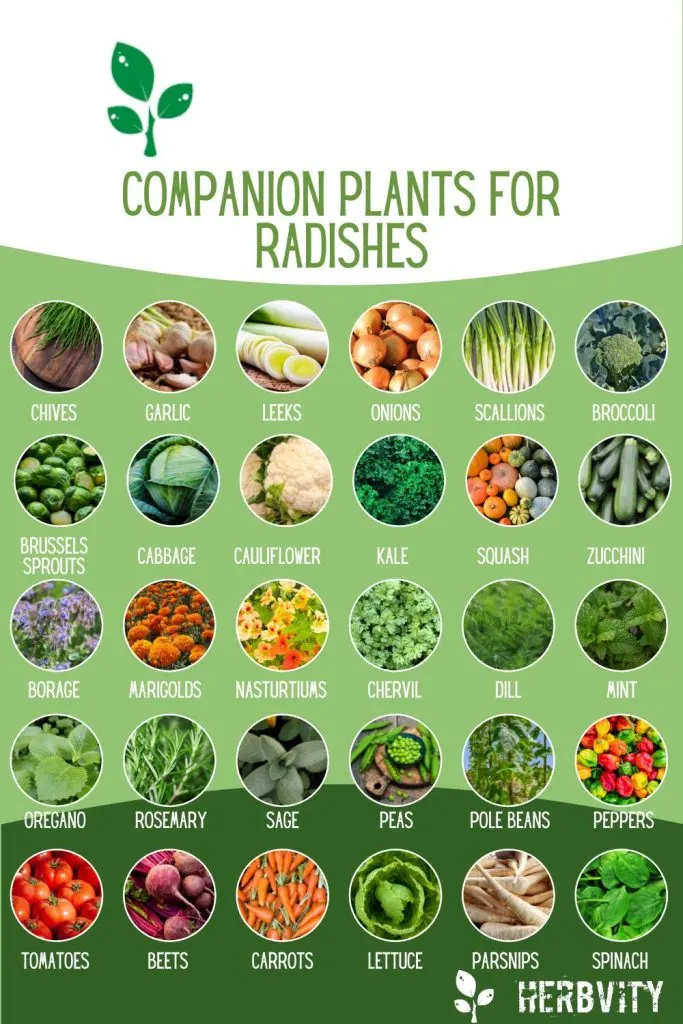
FAQs
What can you not plant next to radishes?

Avoid planting these next to radishes: corn, fennel, hyssop, kohlrabi, melons, potatoes, pumpkins, sunflowers and turnips.
What is best to plant next to radishes?
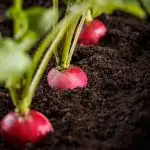
It is best to plant alliums (chives, garlic, leeks, onions, scallions, shallots), flowers (borage, marigolds, nasturtiums), herbs (chervil, dill, mint, oregano, rosemary, sage) and legumes (beans, peas, lentils, alfalfa, soybeans) next to radishes.
Where is the best place to plant radishes?
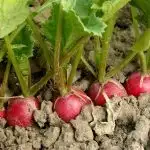
A sunny spot is the best place to plant radishes in the cooler parts of the year. They also thrive underneath partial shade but might need full shade in warmer parts of the year.
Can you plant marigolds with radishes?
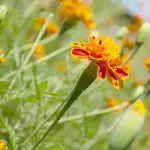
Yes, you can plant marigolds with radishes, as marigolds can help repel pests and promote healthy growth in the radish patch.
Are radishes good companions for tomatoes?
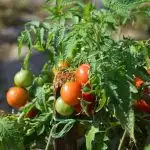
Yes, radishes can be good companions for tomatoes, as they can help deter certain pests, such as aphids and tomato hornworms, and their quick growth allows for efficient use of garden space.
Conclusion
Radishes are edible root vegetables in the cabbage family that come in different types and colors, from white to purple and even red. Listed and explained above are thirty (30) good and nine (9) bad companion plants for radishes.
Radishes are about 95.3% water, 3.4% carbohydrates, and their fat and protein contents are very little. They are also rich in vitamins and minerals.
They provide the body with vitamins B1 (thiamine), B2 (riboflavin), B3 (niacin), B5 (pantothenic acid), B6, B9 (folate), C, and the minerals calcium, iron, magnesium, manganese, potassium, phosphorus and zinc.
Some health benefits of eating radishes include the supply of antioxidants and minerals, decreased blood pressure, reduced risk of heart disease and provision of natural nitrates that improve blood flow.
Radishes are spicy, crisp and zesty in taste when eaten raw. They come in different types that may be very spicy to very mild. They are safe to consume but eating radishes in large quantities may cause flatulence, cramps and irritation to the digestive tract.
While growing radishes, remember that they need exposure to full sun, well-drained, consistently moist soil with pH of between 6.0 and 7.0, steady and even levels of moisture and cool, loose soil for the best or optimal results.
More companion plants
